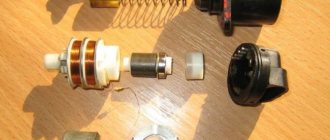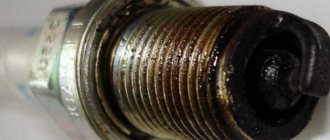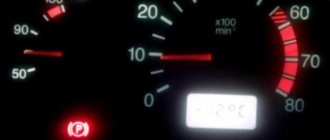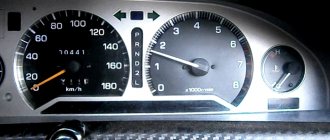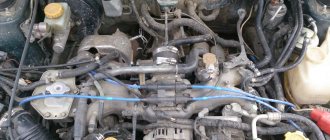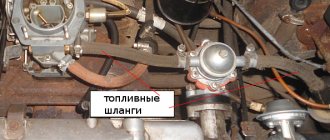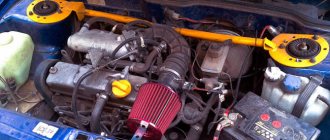List of reasons for stopping the carburetor engine of VAZ 2108, 2109, 21099, 2105, 2107 cars and their modifications while driving (on the move). This problem can arise due to malfunctions in various engine systems: fuel, ignition, etc.
List of main malfunctions that lead to a car engine stalling while driving
The gas tank has run out of fuel
In one case, the readings from the fuel level sensor may simply be incorrect (it has failed). In another case, even if the sensor shows that there is little fuel left in the tank, the fuel intake in such a situation draws water, dirt, sediment and deposits from the bottom of the gas tank. The engine will not work with such a mixture and will stall, even while driving, even at idle. It is recommended to periodically flush the gas tank and fuel lines as a preventive measure to avoid such a problem.
Gas tank
Broken or clogged fuel line
Loose metal and rubber fuel pipes can break and fray over time. This will cause the engine to leak or reduce fuel supply, causing it to stall while the vehicle is moving. To prevent the occurrence of such malfunctions, it is recommended to periodically visually inspect the fuel lines along their entire length. It is also worth focusing on the persistent smell of gasoline that arises in this case.
In addition, as described above, all kinds of dirt and water can be drawn into the fuel lines from the tank. During the cold season, the presence of water in the fuel lines can lead to freezing.
Fuel hoses, the breakage or damage of which are the most dangerous, since fuel can get into the hot manifold and lead to a fire, the condition of these hoses must be constantly monitored
Disconnecting the central high voltage wire (armored wire)
A poorly secured central high voltage wire from the ignition coil to the distributor cap can become disconnected (jump off) while the vehicle is moving, causing the spark to disappear and the engine to stop. In some cases, this situation is accompanied by a bang in the muffler. It is necessary to visually verify the integrity of the central wire and the tightness of its tips in the sockets of the coil and cover.
Central armored wire
Broken wire in the low voltage circuit
First of all, these are low voltage wires of the ignition system (going to the coil, distributor, other devices of the ignition system, plugs of the fuse mounting block). Secondly, it is a “mass” wire connecting the battery and the body (“ground”) of the car. Its break or loose connection will lead to the engine stopping while driving, with the simultaneous disappearance of light in the control instruments on the panel, failure of direction indicators, sound signals, etc. It is necessary to visually inspect the low voltage wires, find the loose ends, and restore the “mass” connection wires. To help, diagrams of the ignition system 2108, 2109, 21099 and 2105, 2107.
Violation of the ignition timing angle
Sudden destruction of the elements of the ignition distributor (breakage or jamming of the springs of the centrifugal regulator), loosening of the elements and their displacement. Loosening the fastening of the distributor itself will lead to a shift in the ignition timing in one direction or another and the engine stopping while driving. In such a situation, only a visual inspection of the distributor and troubleshooting followed by setting the ignition timing (2108, 2109, 21099 or 2105, 2107) will help.
Distributor of cars 2108, 2109, 21099
Breakdown of the capacitor to ground
Malfunction for VAZ 2105, 2107 cars with a contact ignition system. The capacitor on the distributor may suddenly fail, and the engine will stall while driving. This malfunction is accompanied by “shooting” at the muffler. The capacitor must be checked and replaced if faulty. As a temporary measure, it is recommended to disconnect its wire from the “K” terminal of the breaker and move on. You can also use an audio capacitor. We connect its wire to the “P” terminal of the ignition coil, and the housing to ground.
“Sucking” foreign air into the power system
In this case, the fuel mixture becomes very lean and the engine stalls. This can be caused by a poorly secured carburetor (air is sucked under its flange) or intake manifold. The malfunction is eliminated by tightening the carburetor and manifold mounting nuts or replacing the gaskets under them.
Places where foreign air can leak into the carburetor on VAZ 2108, 2109, 21099
The valve timing is out of whack
Perhaps a loose timing belt (on 2108, 2109, 21099) has jumped a tooth or two.
Troubleshooting options
It is clear that if any emergency situations arise with the motor, it is advisable to contact a specialized service. However, this procedure is not always possible. Therefore, it is worth knowing how to independently diagnose the main systems and key parts.
Throttle valve and assembly
When the speed drops at idle and the car stalls, you need to pay close attention to the details of the throttle assembly. Long-term operation of the car on low-quality fuel, untimely maintenance of the air filter can lead to malfunctions of the throttle valve
It periodically jams if debris gets into the equipment.
Throttle valve VAZ 2112
The problem can be solved by cleaning the system. The throttle is cleaned using carburetor cleaners. Using a compressor, you need to blow out the damper under the pressure of compressed air. It is not recommended to touch the screws located inside and on the side. If cleaning does not correct the situation, the device must be replaced. This operation is not particularly difficult.
Crankcase malfunction
There is an oil trap in the crankcase ventilation system of the engine. Its contamination can also lead to interruptions in engine operation. Crankcase gases do not allow the engine to function normally, the speed fluctuates, the internal combustion engine stalls.
Sensors
If a gasoline car stalls at idle, then one of the sensors is likely to break. In injection cars with an electronic engine control system, the engine usually starts normally, but then it stops working. It's worth checking here:
- Electronic car indicators;
- DRХХ – device that regulates idle speed;
- Air flow meter (air intake in the carburetor);
- Sensor indicating the position of the throttle curtain.
Electronic control unit in VAZ 2114
Interruptions in the operation of any sensors immediately affect the behavior of the electronics - errors appear in the car control unit. The “brains” of the machine receive unreliable information. It is not transmitted correctly to the engine. It starts working with parameters that do not correspond to reality. Self-testing of this device is not possible. You need to contact a professional for service.
Diagnostics of mass air flow sensor
The idle air control device is usually to blame for engine malfunction when the car idles poorly. But you pressed the gas pedal and the engine started. In the latest VAZ modifications, error information appears on the instrument panel.
When diagnosing, you must use a multimeter. If a part is faulty, it is recommended to replace it with a new one. All sensors are reasonably priced. It is better to start checking with parts that have a simpler design. Then gradually move on to complex devices. We must not forget that the problem may lie not only in the sensors themselves. It is also necessary to check the wiring to them and the presence of stable contact.
Carburetor
If the VAZ carburetor stalls at idle speed, then the jets may become clogged. Low-quality gasoline, deposits from the gas tank, contain small particles of debris. They can easily disrupt the operation of the fuel injection system. It is worth replacing the filter in front of the carburetor and cleaning the device itself. The dispensing part is cleaned using a cleaning solvent, which is sold in aerosol cans. Another reason is often a prolonged lack of carburetor adjustment.
In a mechanical fuel pump of carburetor cars, the filter mesh may be clogged with dirt. This reduces the performance of the device. Wear of the membrane and its destruction often leads to clogged carburetor channels.
Injector
A situation that often arises is that various Lada models, as well as the VAZ 2110 injector stalls at idle. It is necessary to check the fuel pump strainer for clogging. This is a common problem with injection machines. It is better to immediately replace the part with a working one.
Filter problem
If the VAZ 2112 stalls at idle, then the fuel filter may be dirty. This also applies to other models of the concern. Generally, it is not practical to clean it. The part must be replaced. The same should be done with a dirty air filter. Low throughput leads to the fact that the air-fuel mixture simply floods the spark plugs.
Self-checking will not always lead to a positive result. It is often more practical to identify the cause of unstable operation of the internal combustion engine at a car service center. It will cost more, but specialized diagnostics will prevent more serious damage to the car.
Source
Idle speed for VAZ 2109
One of the reasons that the VAZ-2109 starts and stalls is problems with idling. The VAZ-2109 is equipped with Solex carburetors. It is almost impossible to distinguish carburetor components by appearance; there are differences in internal parts. The idle system in carburetor units regulates the minimum engine speed and is responsible for fuel consumption.
"Solex" consists of the following elements:
- Air jet.
- Channels through which air and fuel are supplied.
- Solenoid valve with fuel jet.
- Speed screw.
- A needle that sets the quality of the fuel-air mixture.
The speed screw adjusts the throttle position. It should always be slightly open so that the fuel mixture flows through the carburetor into the engine at low speeds. The mixture is directed in portions, which occurs thanks to jets. The enrichment and unification of the mixture is ensured by the adjusting needle. The solenoid valve with the fuel nozzle is responsible for the fuel supply.
How does this relate to idle speed? Failure of the solenoid valve or clogged channels leads to the fact that the required doses of air are no longer delivered to the intake manifold.
In this regard, the engine loses the ability to fully perform its functions and breakdowns occur:
- The VAZ-2109 carburetor starts and immediately stalls due to the lack of idle speed.
- The presence of idle speed in this case does not guarantee the possibility of movement, since engine operation is unstable.
- The car loses momentum.
Actions in case of loss of idle speed
The solenoid valve should be checked first. To do this you need:
- Turn on the engine and increase the speed with the speed screw (this is done to prevent the car from stalling).
- Then, without stopping the engine, remove the solenoid valve wire.
- If there are no changes in engine operation, make sure there is power to the valve. This is done by connecting the wire to the solenoid valve. The tension will make itself felt through a small click.
The absence of voltage indicates that the economizer control unit has stopped working or there is a break in the wiring. It is likely that the idle speed disappeared for this reason.
If there are no problems with the power supply, the operation of the solenoid valve is checked directly:
- The fuel jet is removed.
- The solenoid valve housing is installed on the ground terminal of the power source and the positive is connected to the contact.
The valve works if its needle works, that is, “sinks”.
Idle speed may not appear in this case either. Then you should clean the valve jet and blow out the idle passages.
Step-by-step instruction:
- The solenoid valve and air filter housing are removed and the engine is turned on.
- The throttle must be operated by hand. At the same time, the idle channel is clamped with this finger.
- You need to apply gas several times with the throttle valve and release your hands so that the engine runs without a valve.
- Turn off the engine, install all parts in place and check for idle speed.
If a trickle of gasoline is leaking from the nozzle, visible to the naked eye, this means that there is a problem with the carburetor. This moment is noticeable when the engine is running at low speeds.
Ways to prevent breakdown
To avoid this, it will help to completely flush the injector and diagnose your vehicle after 30 thousand kilometers. But it is necessary to take into account that the problem may be hidden simply in a malfunction of the sensor itself for measuring speed.
Everything here, of course, is very simple, you need to go to the store and buy it, it costs about 200 rubles and the process of replacing the sensor is not very difficult.
There are countless stories about the complete assembly and disassembly of the legendary “nine”, followed by the normal functioning of the unit, taking into account the remaining “extra” parts.
If it is not possible to fix the problem yourself, it is better to contact specialists, they will definitely help, do not forget that poor-quality car repairs can only lead to new, often more serious, breakdowns. And then you will definitely have to contact the service, paying much more money than you could have paid before. Take care of your lives and cars.
Source
Symptoms of a faulty engine control unit (ECU)
The engine control unit (ECU), also called the engine control module or transmission control module, is one of the most important components found on almost all modern vehicles. Essentially, it functions as the main computer for many of the car's engine and driving functions. The controller receives information from various engine sensors and uses this information to calculate and adjust the engine's spark and fuel for maximum power and efficiency.
The ECU plays a critical role in newer vehicles, where many (if not all) of the vehicle's major functions are controlled by the ECU. When the ECU has any problems, it can cause all sorts of problems with the vehicle, and in some cases even render it unusable. Typically, a bad or faulty control unit will cause several key symptoms that can alert the driver to a potential problem.
Check if the Check Engine Light comes on
An illuminated check engine light is one possible sign of an ECU problem. The check engine light usually comes on when the computer detects a problem with any of its sensors or circuits. However, there are cases when the control unit turns on the check engine light by mistake, or when there is no problem. Scanning your computer for trouble codes can help reveal whether the problem is with the control unit or elsewhere in the vehicle.
The engine stalls or does not start
Another sign of a bad or faulty control unit is erratic engine behavior. A faulty computer can cause your car to experience intermittent problems such as freezing or misfires. Symptoms may come and go and may not have any pattern to their frequency or severity.
Engine problems
Problems with engine operation are another sign of a possible problem with the control unit. If the control unit has any problems, it can reset the engine's valve timing, which can negatively impact performance. A faulty ECU can cause decreased fuel efficiency, power, and acceleration.
The car won't start
Another sign of a bad or faulty control unit is a car that won't start or is difficult to start. If the control unit fails completely, it will leave the vehicle without engine control control and, as a result, will not start or start. The engine may still start, but it will not be able to start without important data from the computer. This symptom can also be caused by a number of other problems, so it is best to get a full diagnosis from a professional to pinpoint the cause.
Since the control unit plays such an important role in the operation of the engine, any problems with it can cause serious problems with the overall functionality of the vehicle. Because the computer systems used in modern cars are quite complex and also difficult to diagnose. For this reason, if you suspect that there is a problem with your vehicle's control module, have the vehicle inspected by a professional technician to determine if your vehicle will need an engine control module replacement.
Source
How does a contactless ignition system work?
The distributor sensor is driven by rotation of the crankshaft, generating low voltage pulses that are transmitted to a transistor switch. The commutator, in turn, creates current pulses in the primary winding of the ignition coil. When the current is interrupted, a high voltage current is induced in the secondary winding of the ignition coil, after which the high voltage current is applied to the center contact of the distributor. Depending on the firing order of the engine cylinders, high voltage current is distributed through the high voltage wires to the spark plugs. Spark plugs ignite the combustible mixture.
Determining the quality of the spark
At this stage, you need to understand whether there is voltage on the spark plugs. To do this, just unscrew one spark plug and connect the central electrode to the high-voltage wire. Next, ensure that the threads are in contact with the ground of the car and turn on the ignition. A stable spark of blue (white-blue) color indicates that everything is fine with the ignition.
Check the remaining spark plugs in the same way. Because a common reason for an engine to fail to start is the failure of one of these parts.
Initially, the engine starts and tries to operate on two or three cylinders. You may notice that the internal combustion engine is shaking and the vibration from it increases.
After working for a while in this mode, the engine will stall.
Cylinders with non-functioning spark plugs are simply filled with too much gasoline and the situation will repeat itself when the engine is restarted. If there is a spark on all spark plugs, evaluate their color and size. Yellow/red color and small size also indicate that the car will start and subsequently stop working.
Types of input and output signals
The ECU processes only a few types of input signals:
- digital signal (has only two levels - “high” and “low”). This signal is also called logical, since it has only two values - true or false (true/false), logical 0 or logical 1;
- a pulse signal is a short-term change in a physical quantity. For example, based on the number of pulses from the ABS sensor, the control unit calculates the rotation speed of each wheel;
- analog signal – described by a function of time and a continuous set of possible values. In a car, these signals include voltage measurements.
Master cascades used to control actuators can generate a switching signal and a pulse-width modulated signal
A PWM signal is characterized by the duty cycle of the pulses - the ratio of the period of the pulses to their duration. The duty cycle is expressed as a percentage, which shows the ratio of the period of voltage supply to the period of de-energized state
For example, if the duty cycle of the idle air regulator (IAC) control signal is 50%, then the regulator rod will be extended halfway.
While pulse width modulation allows flexible control of the actuator, the switching signal has only two states - on or off. This signal will be the inclusion of a fan, air conditioner clutch, etc.
The car engine stalls while driving
The gas tank has run out of fuel
In one case, the readings from the fuel level sensor may simply be incorrect (it has failed). In another case, even if the sensor shows that there is little fuel left in the tank, the fuel intake in such a situation draws water, dirt, sediment and deposits from the bottom of the gas tank. The engine will not work with such a mixture and will stall, even while driving, even at idle. It is recommended to periodically flush the gas tank and fuel lines as a preventive measure to avoid such a problem.
Broken or clogged fuel line
Loose metal and rubber fuel pipes can break and fray over time. This will cause the engine to leak or reduce fuel supply, causing it to stall while the vehicle is moving. To prevent the occurrence of such malfunctions, it is recommended to periodically visually inspect the fuel lines along their entire length. It is also worth focusing on the persistent smell of gasoline that arises in this case.
In addition, as described above, all kinds of dirt and water can be drawn into the fuel lines from the tank. During the cold season, the presence of water in the fuel lines can lead to freezing.
Disconnecting the central high voltage wire (armored wire)
A poorly secured central high voltage wire from the ignition coil to the distributor cap can become disconnected (jump off) while the vehicle is moving, causing the spark to disappear and the engine to stop. In some cases, this situation is accompanied by a bang in the muffler. It is necessary to visually verify the integrity of the central wire and the tightness of its tips in the sockets of the coil and cover.
Broken wire in the low voltage circuit
First of all, these are low voltage wires of the ignition system (going to the coil, distributor, other devices of the ignition system, plugs of the fuse mounting block). Secondly, it is a “mass” wire connecting the battery and the body (“ground”) of the car. Its break or loose connection will lead to the engine stopping while driving, with the simultaneous disappearance of light in the control instruments on the panel, failure of direction indicators, sound signals, etc. It is necessary to visually inspect the low voltage wires, find the loose ends, and restore the “mass” connection wires. To help, diagrams of the ignition system 2108, 2109, 21099 and 2105, 2107.
Violation of the ignition timing angle
Sudden destruction of the elements of the ignition distributor (breakage or jamming of the springs of the centrifugal regulator), loosening of the elements and their displacement. Loosening the fastening of the distributor itself will lead to a shift in the ignition timing in one direction or another and the engine stopping while driving. In such a situation, only a visual inspection of the distributor and troubleshooting followed by setting the ignition timing (2108, 2109, 21099 or 2105, 2107) will help.
Breakdown of the capacitor to ground
Malfunction for VAZ 2105, 2107 cars with a contact ignition system. The capacitor on the distributor may suddenly fail, and the engine will stall while driving. This malfunction is accompanied by “shooting” at the muffler. The capacitor must be checked and replaced if faulty. As a temporary measure, it is recommended to disconnect its wire from the “K” terminal of the breaker and move on. You can also use an audio capacitor. We connect its wire to the “P” terminal of the ignition coil, and the housing to ground.
“Sucking” foreign air into the power system
In this case, the fuel mixture becomes very lean and the engine stalls. This can be caused by a poorly secured carburetor (air is sucked under its flange) or intake manifold. The malfunction is eliminated by tightening the carburetor and manifold mounting nuts or replacing the gaskets under them. For more information about “suction”, see “Suction of foreign air into the carburetor”.
The valve timing is out of whack
Perhaps a loose timing belt (on 2108, 2109, 21099) has jumped a tooth or two.
Notes and additions
— In addition to the listed reasons for the sudden stop of a carburetor engine, there are several others. For example, dirt getting into the carburetor and clogging of the GDS jets.
Source
Injection motor power sensors
At this stage of the inspection, you need to look at the dashboard. As a rule, all malfunctions are noticed by the electronic control unit. When a breakdown occurs, the driver is immediately notified via a Check signal. Accordingly, you need to immediately test the devices for error codes. If this is not possible, you should check the IAC and MAF sensors.
The most common problem is a faulty mass air flow sensor, in which the car starts and stalls after a while. This device determines the amount of air that passes through a special channel into the intake system. The control unit regulates the mixture concentration in the engine. If there is a malfunction of this sensor, the mixture is already formed incorrectly. The consequence of this is an increase in gasoline consumption, unstable speed when idling, as well as problems with starting the internal combustion engine.
The IAC is also responsible for the correct operation of the engine. It receives a signal from the ECU about the required amount of air and mechanically regulates the incoming air masses into the engine. The device is directly involved in starting the internal combustion engine and its subsequent operation.
What to do if cars with automatic transmission stall?
If your vehicle has an automatic transmission, then the problem should be found in the electrical supply. If you abruptly switch from one gear to another, or while switching gears while braking, the settings may be distorted, and the on-board computer will receive a signal to turn off the engine.
Also, models with automatic transmission may stall due to malfunctions of the hydrodynamic transformers of the gearbox. This problem mainly manifests itself during acceleration and requires urgent intervention from car service specialists.
ECU malfunctions
- corrosion of the soldering area, short circuit between the terminals of the elements on the board due to moisture getting inside. The ECU controller is placed in a sealed housing, which should prevent water from penetrating inside the unit. The above malfunctions most often occur after opening the unit for inspection/repair, since it is quite difficult to restore factory tightness. Most often, the engine control unit is located in the engine compartment - not the most favorable environment for controllers. Less often, the manufacturer places the ECU under the windshield wiper frill, behind the fender liners or in the passenger compartment;
- malfunction of ECU components due to oil or antifreeze getting inside. Due to capillary effect, it is not uncommon for engine oil or transmission fluid to seep into the block, flowing down or even rising up the wires to the connector;
On some cars, the poor location of the control unit determines the cause of its breakdown. For example, the ECU on Lada Kalina cars is installed under the heater radiator. Therefore, if the latter leaks, antifreeze gets inside the block and disables it.
soldering cracks on printed circuit board elements. They arise due to constant temperature changes and vibrations. Some manufacturers install an ECU on the engine, which aggravates the impact of negative factors and becomes the main cause of engine ECU failure;
- burnout of elements on the board due to a short circuit, incorrect connection of the battery, overvoltage in the on-board network;
- oxidation of pins in the contact connector, bending of contacts after careless installation of the ECU connector.
Causes
The most dangerous thing in this case is inaction. Today we will talk about why the idle speed on the VAZ 2114 jumps, what are the reasons and what actions should be taken in this or that situation.
In fact, the reasons can be very different, so we will try to comprehensively study this issue.
Electronic control unit
It is not uncommon that the electronic brains of the VAZ 2114 car become the source of all problems associated with idle floating speed. If a sensor fails, this affects the ECU receiving incorrect information. Consequently, the engine does not operate at the parameters it needs.
Unfortunately, it will not be possible to independently diagnose and identify malfunctions of the electronic control unit. This requires appropriate experience, special equipment and tools. Therefore, this issue is resolved in a high-quality car service and nothing else.
Sensors
If the injection VAZ 2114 stalls at idle, the problem lies in the sensors sending incorrect signals to the electronic control unit.
Article on the topic: How to tighten the steering rack on a VAZ 2110 with your own hands?
There are three sensors that may cause engine malfunction:
- Idle air control or IAC;
- Mass air flow sensor or mass air flow sensor;
- EGR.
If the check shows that the sensors are working properly, then the causes of the breakdown should be looked for in the spark plugs and air filter. And don’t look for the problem only in the sensor itself. It is possible that the wiring connecting it to the ECU is damaged.
Let's look at problematic sensors that potentially cause floating speed in more detail.
RXX
If your VAZ 2114 stalls at idle, and it has an injection engine, look for the problem first of all at the IAC sensor. It is mounted on the throttle body, so you can find it near the throttle position sensor. The element we are looking for is secured with two screws.
To check the IAC you will need a multimeter:
- Turn on the ignition;
- Disconnect the wiring block from the sensor;
- Using a multimeter, measure the resistance between the sensor contacts;
- The normal value is about 40-80 ohms;
- If the received data does not fall within the specified range, the regulator has failed;
- The only correct solution to the problem is to replace the sensor.
Mass air flow sensor
Next in line will be the mass air flow sensor. It is not uncommon for this to cause floating rpm at idle.
To check, you will also need a device called a multimeter. The voltage is measured between two contacts. The mass air flow sensor connectors are marked with green and yellow wires.
Mass air flow sensor
Before taking measurements, make sure that the engine is not running and the ignition is on. The normal range of the multimeter is 0.999-1.02V. If the data is different, the sensor is faulty. As in the first case, the device is replaced with a similar new one.
EGR
This valve is a sensor that belongs to the exhaust gas recovery system. The valve sends some of these gases into the combustion chamber, which ensures more efficient combustion of the fuel. Consequently, the level of toxicity of emissions into the atmosphere is significantly reduced.
The device has a simple design, but nevertheless, it is quite rare that it causes the phenomenon that we are considering today.
The valve seat must be cleaned periodically, otherwise it will negatively affect the stability of the injection power unit. If cleaning has not been carried out for a long time, correct the situation. To do this, use special sprays designed for cleaning the carburetor. Just make sure that the substance does not get on the sensor diaphragm.
Article on the topic: Selection and installation of seats on the VAZ 2114
Effect of air leaks in the fuel system
Unstable operation of the internal combustion engine, failures during acceleration of the car can also occur due to air leaks in the fuel system (TS), because as a result of the appearance of excess air mass, the proportion of the mixture necessary for the complete combustion of gasoline in the cylinders is disrupted. Air suction can occur:
It is quite easy to check whether VUT affects the stability of the engine; you need to disconnect the “vacuum” hose from the intake manifold, plug the fitting, and start the engine.
If, after installing the plug on the fitting, the engine operation is leveled out and it no longer “trips”, we have correctly identified the cause of the malfunction. Sure signs of leakage in such cases: a noticeable hiss of air in the area of the “vacuum chamber”, engine stopping or a sharp drop in speed after pressing the brake pedal. The power mode economizer (EMR) also affects the stability of the idle speed; more precisely, its diaphragm, if it is broken, the engine will not work normally at low speed. In any case, it is worth checking the condition of this part; you can remove the diaphragm without dismantling the carburetor (unscrew 3 screws).
Common causes of floating revolutions
So, we figured out the main symptoms. Now let's move on to the reasons. Let us immediately note that floating idle speed is often a problem with injection engines. The fact is that a complex ECM system is responsible for idling in this case.
This system assumes the presence of a controller, sensors and actuators. The control unit receives signals from sensors and transmits commands to actuators (for example, IAC), maintaining stable engine speeds at idle and other modes, regardless of the load on the internal combustion engine.
However, any failures that are associated with the supply of air, fuel, a violation of the composition of the working fuel-air mixture or its ignition, as well as various mechanical breakdowns will lead to floating speed.
As a rule, in practice, the idle air regulator causes a lot of problems for drivers. In fact, this is a stepper motor that has a conical locking needle. When the throttle valve is closed, air bypasses the valve through a channel that is closed by the needle.
If malfunctions occur in the operation of the device, the ECU is not able to correctly “select” the mixture composition at idle, as a result, the speed floats.
The mass air flow sensor also deserves special attention. During operation, the air flow sensor may become dirty or break down.
One way or another, the ECU does not receive correct data on air flow, which leads to disruption of mixture formation and jumps in engine speed.
Often, a floating engine speed can be associated with severe contamination of the throttle valve itself or mechanical breakdowns of the throttle, damage, or deformation. The damper may jam and not close completely.
To prevent such complications, it is necessary to periodically clean the throttle from dirt, and on many cars, additional training of the throttle is required after cleaning.
During diagnostics, you should also check the crankcase ventilation valves. Normally, crankcase gases are redirected to the intake, where they are mixed with air and fuel, after which they are burned in the cylinders.
By the way, if you touch on carburetor engines, the speed on the carburetor floats, usually due to the settings and adjustments of this device being messed up. Also, one should not exclude the possibility of a breakdown of the carburetor solenoid valve or clogging of the idle jet.
Let’s also add that if the speed of a diesel engine fluctuates, this is often caused by rust on the fuel injection pump blades. Corrosion occurs due to the presence of water in diesel fuel.
When the engine warms up, the speed of the VAZ 21099 injector drops
- Registration
- Entrance
- To the beginning of the forum
- Forum Rules
- Old design
- FAQ
- Search
- Users
OZONE carburetor? Then this is his feature
This is always observed at near-zero temperatures.
And another question at what speed should it be warmed up?
Everyone has a different opinion.
And another question: at what speed should it be warmed up? Everyone has a different opinion.
I have the same garbage 2000 21074 carb 21073. It warms up, lowers it a little, then increases.
I have the same garbage 2000 21074 carb 21073. It warms up, lowers it a little, then increases.
started after rebuilding the carburetor (assembled one of the two), even when the exhaust stinks of gasoline, everything warms up
What if carb
not OZONE, but
Solex
and there is such crap, what could it be?
Now on topic and fact
practically: In the morning before starting, we prepare the possibility of adjusting the air damper limit screw. Many people have to remove the air filter housing, but it is still better to have a long, narrow screwdriver. Next, we start the engine and, at the ready, insert a screwdriver into the hole and, having “groped” for the slot of the adjusting screw, insert it into this slot. Now, as soon as the engine begins to lose speed as it warms up, by adjusting this screw (usually by unscrewing it) we obtain the desired maximum speed when warming up. That’s the whole “problem” of the heating mode in Ozone.
Thank you! Need to try
We can’t talk about icing - the problem is around “0” degrees.
Rezo wrote:
We can’t talk about icing - the problem is around “0” degrees.
Let me disagree, I won’t argue with ozone, but on bakers (Volga) icing begins when warming up already at +10 and strong humidity. The XX unit freezes.
Secondly, it can be cured by heating.
In the morning before starting, we prepare the possibility of adjusting the air damper limit screw. Many people have to remove the air filter housing, but it is still better to have a long, narrow screwdriver. Next, we start the engine and, at the ready, insert a screwdriver into the hole and, having “groped” for the slot of the adjusting screw, insert it into this slot. Now, as soon as the engine begins to lose speed as it warms up, by adjusting this screw (usually by unscrewing it) we obtain the desired maximum speed when warming up. That’s the whole “problem” of the heating mode in Ozone.
In the morning before starting, we prepare the possibility of adjusting the air damper limit screw. Many people have to remove the air filter housing, but it is still better to have a long, narrow screwdriver. Next, we start the engine and, at the ready, insert a screwdriver into the hole and, having “groped” for the slot of the adjusting screw, insert it into this slot. Now, as soon as the engine begins to lose speed as it warms up, by adjusting this screw (usually by unscrewing it) we obtain the desired maximum speed when warming up. That’s the whole “problem” of the heating mode in Ozone.
Now on topic and fact
practically: In the morning before starting, we prepare the possibility of adjusting the air damper limit screw. Many people have to remove the air filter housing, but it is still better to have a long, narrow screwdriver. Next, we start the engine and, at the ready, insert a screwdriver into the hole and, having “groped” for the slot of the adjusting screw, insert it into this slot. Now, as soon as the engine begins to lose speed as it warms up, by adjusting this screw (usually by unscrewing it) we obtain the desired maximum speed when warming up. That’s the whole “problem” of the heating mode in Ozone.
The speed drops sharply and IMHO it will not be possible to adjust normally because of this
By the way, I tried to pull out the choke completely at 90 degrees. — the revolutions increase to 2.5k, there are no dips, but if I understand correctly, when the engine is warm (with the engine adjusted normally) there should be them, the engine should stop, right?
By the way, I tried to pull out the choke completely at 90 degrees. — the revolutions increase to 2.5k, there are no dips, but if I understand correctly, when the engine is warm (with the engine adjusted normally) there should be them, the engine should stop, right?
I noticed an unpleasant effect: when you unscrew the external screw (the adjusting screw underneath), the speed drops sharply and IMHO it will not be possible to adjust normally because of this.
Where does this information come from? quote]
It was somewhere in this forum. I think Rezo mentioned something similar in one of the previous topics about warming up.
Causes of malfunction
Floating engine speed shown on the dashboard
It’s not just that the speed in a car starts to fluctuate; this is due to the operation of many systems. Before we begin to consider the reasons, it is worth noting that with such an effect the check may light up or not, but as practice shows, the outcome of the reasons is the same.
Let's consider the main problems of the occurrence of floating speed at idle according to the practice of car enthusiasts and service manuals:
Method for eliminating floating speed on a 16-valve VAZ-2112
Before we move on to eliminating the causes, it is worth noting that untimely repairs can lead to the engine reaching the “start-stop” effect. This means that the engine will start and immediately stall at idle. Therefore, at the slightest occurrence of floating speed, it is worth eliminating the problem. So, let's move on to the actual repair.
Fuel system and everything connected with it
The effect of floating idle speed can occur due to intermittent injection. On older carburetor cars this happens quite often, especially during and after winter. So, to eliminate the causes on the VAZ-2112, it is necessary to perform the following operations:
- Check the operation of the gasoline pump, repair or replace if necessary.
- Replace the fuel filter, which may be clogged due to poor quality fuel.
- Check and clean injection nozzles. If necessary, replace faulty injectors.
- Check the fuel rail for leaks.
- Carry out diagnostics of injector wiring.
If the cause is found, then you should check whether the effect of floating speed has disappeared; if not, then examine the remaining systems.
General view and diagram of the fuel system
Ignition
The car's ignition plays a very important role in setting the speed. It is worth noting that a malfunction of spark plugs (incorrectly selected gap), high-voltage wires or lock can affect the achievement of this effect. Therefore, it is necessary to diagnose these particular components and parts, and, if necessary, replace them.
Replacing the ignition switch can eliminate floating speed
Bad gasoline
Now, the market for fuels and lubricants is quite actively saturated with counterfeits, and therefore even at trusted gas stations you can fill up with low-quality or “bodied” gasoline. This is one of the reasons for floating idle speed. To eliminate the problem, it is necessary to clean the entire fuel system. To do this, do the following operations:
- Remove and then clean the fuel tank.
- Replace the fuel filter.
- Remove the fuel rail and clean the injectors using a special stand.
- Blow out the fuel lines.
- Remove the fuel pump and clean (replace) the coarse strainer.
- Check the condition of the engine cylinders (this is not necessary, but recommended).
Poor quality fuel is one of the reasons for floating speed
Idle speed sensor
Like any engine and electrical part, the idle speed sensor has its own resource and service life, and therefore can fail. It is necessary to unscrew it, carry out diagnostics and, if necessary, replace it with a new one.
The idle speed sensor may be the main cause of floating speed
Throttle
A clogged throttle valve often caused the car to experience the effect that the speed began to float. Therefore, it is necessary to diagnose the condition of this element, and if necessary, clean it.
Throttle valve before and after cleaning
ECU errors
The accumulation of errors in the electronic control unit can lead to various incorrect commands. One of them may be idle speed. So, to fix the problem, you need to connect to the car using a special cable and reset all accumulated errors in the ECU.
Possible ECU error codes
VAZ 21099 Injector Starts and Stalls Immediately
Why does the VAZ injector start and stop immediately?
Situations often arise when the VAZ injector starts immediately and then stops. And all the rest through the fuel injection system (forced type). To correct this situation, car owners often use a warming candle, but this is not a solution, but a temporary measure. If the VAZ 2107 starts and stops immediately
After returning the key to the ignition switch, this almost always indicates a problem with the fuel supply (the fuel pump is clogged or the fuel pump is not working properly) or the quality of the fuel used is poor and the injectors are simply clogged. And the car starts only on the fuel remaining in the cylinders.
Finding the faulty component
What else should you do if the engine just starts, but then immediately slows down and stops? First you need to check the carbon deposits on the spark plugs. If some models are covered with a layer of soot, the a priori engine is not allowed to operate normally. It starts with the starter moving, but then immediately slows down because the few cylinders on the physical plane are unable to support the entire load from the crankshaft. The carburetor, when, can also fail due to this task.
READ Heater Fan VAZ 2107 Doesn't Work
So what is the cause of engine failure? If the car starts, then at least with a spark, which remains normal for our client. In other words, the electrician is working as expected. It will be useful to spin your head around and try to find candles covered with a layer of soot. They can be cleaned by burning them over a gas burner and cleaning with alcohol (only when the contacts have cooled, of course).
The injector itself
can laugh too Therefore, the supply of fuel to the combustion chamber simply does not work. The following steps are required:
- remove blocks and check gateways;
- check the operation of the sensors;
- Make sure the engine runs normally at temperatures above 80ºC.
The car started to cool down and immediately
deaf. He removed the chip from the DMRV sensor and the car started. How tired you are.
21099 Kiosks
Previously, it was delayed when pressing the accelerator pedal at the moment. almost immediately
after launch the rest. on video.
How can the fuel pump itself fail? When the engine starts, it automatically turns into an injector using the starter, after which the engine separates from the generator. If one of these components doesn't work properly, the machine is just stalled. Here again we are talking about the residual amount of fuel in the cylinders. On the contrary, the engine stops immediately and, with its help, the starter does not work smoothly, most likely this is a problem either on the personal computer, in other words, in the ignition switch
READ How to Remove the Door Trim on a VAZ 2110
Try changing it to preliminary and test the engine. In the latter case, the contacts are simply clamped.
